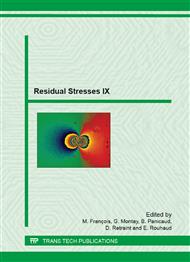[1]
P. Fornara, A. Poncet, Modeling of local reduction in TiSi/sub2 and CoSi/sub2 growth near spacers in MOS technologies: influence of mechanical stress and main diffusing species, Int. Electron Devices Meeting Proceedings, San-Francisco, USA 8-11 December (1996).
DOI: 10.1109/iedm.1996.553125
Google Scholar
[2]
O.S. Narayanaswamy, Stress and structural relaxation in tempering glass, Journal of the American Ceramic Society, 61 (1978) 146-152.
DOI: 10.1111/j.1151-2916.1978.tb09259.x
Google Scholar
[3]
J. Deboucq, M. Duquennoy, M. Ouaftouh, F. Jenot, J. Carlier, M. Ourak, Development of interdigital transducer sensors for non-destructive characterization of thin films using high frequency Rayleigh waves, Review of Scientific Instruments, 82, 064905 (2011).
DOI: 10.1063/1.3600797
Google Scholar
[4]
F.D. Murnaghan, Finite deformation of an elastic solid, Wiley & Sons edit., Inc. New York (1951) 1-140.
Google Scholar
[5]
D.S. Hughes, J.L. Kelly, Second-order elastic deformation of solids, Phys. Review, 92, 5 (1953) 1145-1149.
DOI: 10.1103/physrev.92.1145
Google Scholar
[6]
C. Truesdell, R. Toupin, The classical field theories, in Handbuch der Physik, S. Flügge, Ed. Vol. III/1, Springer-Verlag, Berlin and New York (1960) 1-632.
Google Scholar
[7]
S.H.B. Bosher, D.J. Dunston, Effective elastic constants in nonlinear elasticity, Journal of Applied Physics, 97, 103505 (2005) 1-7.
DOI: 10.1063/1.1894586
Google Scholar
[8]
M. Duquennoy, M. Ouaftouh, D. Devos, F. Jenot, M. Ourak, Effective elastic constants in acoustoelasticity, Applied Physics Letters, 92, 24, 244105 (2008) 1-3.
DOI: 10.1063/1.2945882
Google Scholar
[9]
S. Karlsson, B. Jonson, The technology of chemical glass strengthening - a review, Glass technology-European Journal of Glass Science and Technology Part A, 51 (2010) 41-54.
Google Scholar
[10]
G.W. Farnell and E.L. Adler, Elastic wave propagation in thin layers, Physical Acoustics edited by W.P. Mason and R.N. Thurston, Academic Press, New York, Vol. 9 (1972) 35-127.
DOI: 10.1016/b978-0-12-395670-5.50007-6
Google Scholar
[11]
J.E. Lefebvre, V. Zhang, J. Gazalet, T. Gryba, Conceptual advantages and limitations of the Laguerre polynomial approach to analyze surface acoustic waves in semi-infinite substrates and multilayered structures, Journal of Applied Physics 83 (1998).
DOI: 10.1063/1.366697
Google Scholar
[12]
M. Duquennoy, D. Devos, M. Ouaftouh, D. Lochegnies, E. Romero, Ultrasonic evaluation of residual stresses in flat glass tempering : comparing experimental investigation and numerical modelling, Journal of the Acoustical Society of America, 119, 6 (2006).
DOI: 10.1121/1.2197806
Google Scholar
[13]
M. Duquennoy, M. Ouaftouh, J. Deboucq, J.E. Lefebvre, F. Jenot, M. Ourak, Influence of a superficial field of residual stress on the propagation of surface waves - Applied to the estimation of the depth of the superficial stressed zone, Appl. Phys. Lett., 101, 23 (2012).
DOI: 10.1063/1.4768434
Google Scholar
[14]
M. Duquennoy, M. Ouaftouh, J. Deboucq, J.E. Lefebvre, F. Jenot, M. Ourak, Characterization of micrometric and superficial residual stresses using high frequency surface acoustic waves generated by interdigital transducers, J. Acoust. Soc. Am., 134, 6 (2013).
DOI: 10.1121/1.4826176
Google Scholar


